Appendix
Children's Books
F.N. Monjo, The Drinking Gourd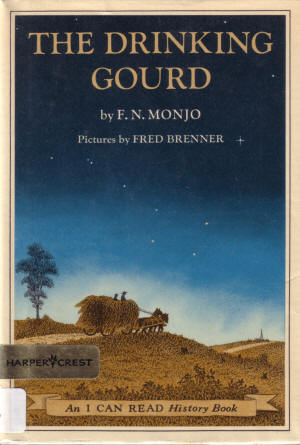
The Drinking Gourd by F.N. (Ferdinand Nicholas) Monjo.
Pictures by Fred Brenner. Harper & Row, 1970: New York, Evanston and
London.
Synopsis
Lee Hays's Follow the Drinking Gourd lyrics appear at the
beginning. The book references the song, but is not based on it.
The story is set in New England in late 1851. Young Tommy Fuller
misbehaves in church and is sent home by his father, the church's
deacon. When Tommy stops in the family barn, he discovers a family of
runaway slaves – two parents, their boy (roughly his age) and a baby –
hidden there by his father. The slaves have escaped from South Carolina
and are following the drinking gourd (which Tommy knows as the Big
Dipper) north to Canada.
When Tommy's father arrives home, he briefly explains the Underground
Railroad, then hitches up the horses and hides the slaves in the wagon.
When they arrive at a riverbank, Deacon Fuller steps away to look for a
boat. US marshals arrive to search for the runaways. Thinking fast,
Tommy says he is running away. The marshals advise him to go home and
take his licking for misbehaving. Father returns and rows the slaves
across the river. That night, father and son discuss the morality of
disobeying unjust laws.
Notes for Parents and Teachers
An "I CAN READ" history book. Suitable for grades K through 2.
If this book is used to introduce children to the Underground
Railroad, parents and teachers may want to explain that this is fiction,
just one escape account out of many thousands, and depicts a series of
unusual circumstances. Most slaves escaping from the Deep South
did not head north.
Most escaped alone; family groups were relatively unusual.
(1)
The Carolinas were not on the Drinking Gourd route, which
extends from Mobile Bay through northwestern Alabama, northeastern
Mississippi, Tennessee and Kentucky to the Ohio River. Also, it would
make little sense for a family who did cross over into freedom in
southern Illinois to make their way to Canada via New England.
Reviews
"Reveals the courage of the runaway slaves who followed the
drinking gourd (the Big Dipper), and the compassion of the men and
women of good will who helped them on their way to freedom."
New York Times
"An exciting and moving adventure story for beginning readers"
Booklist
Awards
Awards
Notable Children's Books of 1940–1970, American Library Association
Library of Congress Children's Books of 1970
Jeanette Winter,
Follow the Drinking Gourd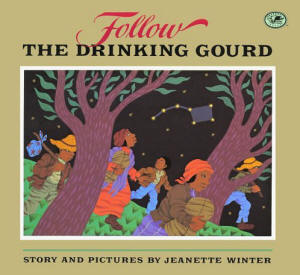
Follow the Drinking Gourd, text and illustrations by Jeanette
Winter, New York: Knopf, 1988.
Synopsis
Peg Leg Joe is presented as a resolute Underground Railroad
conductor, posing as an itinerant carpenter. Joe "had a plan", working
for the master by day, and teaching slaves the Drinking Gourd
song by night. He would then slip away to do the same elsewhere. On one
plantation, the slave James learns he has been sold and will be
separated from his wife, Molly and son, Isaiah the next day. Molly and
James hear a quail call that night, reminding them of the song. (Caveat:
bobwhite quail do not call at night. See
[2]) They set
out immediately with Isaiah, as well as Hattie and her grandson George.
They hide in the trees, listening for hounds. They follow the song,
traveling at night, looking for Joe's marks on the trees lining the
river. They brave hunger, beasts and patrollers.
En route, "...sometimes a kind deed was done. One day, as they hid in
a thicket a boy from a farm found them. In a bag of feed for the hogs in
the wood he brought bacon and corn bread to share."
(3)
From the top of the two hills mentioned in the song, they see the new
path. Continuing to follow the song as it leads them up the Tennessee
River, they are reunited with Peg Leg Joe where it joins the Ohio River.
He rows them across and explains the Underground Railroad. On the far
shore, "Joe signaled low, with a hoot like an owl."
(4)
The escapees are hidden in the barn of a nearby home,
while Joe goes back to the river to await other runaways.
The next station is a Quaker farm. They drive the carriage themselves
– unlikely in southern Illinois at that time. As they work their way north, one
of their hosts is an urban black family – an accurate reference to the major
role that blacks played in the Underground Railroad. At last they arrive
at Lake Erie. Once safely on the Canadian shore, old Hattie cries out,
"'Five more souls are safe!"
(5)
Comments
The book beautifully melds the song directly into the flow of the
story. The audio production features Tony and Drama Desk Awards award
winner Ron Richardson narrating and singing all the parts; Arthur Custer
was the arranger/composer. It's also extremely well done. On a personal
note, this book and audio book were my introduction to the song.
LeVar Burton hosted a television show based on the song and the book.
Jeanette Winter says she "was a big fan of the Weavers in college and
later, and so was familiar with the song." She writes, "A suggestion was
made, I looked into it, and was off into the history of the Underground
Railroad." (personal communication). She read Uncle Tom's Cabin,
slave narratives and other reference works, looking to folk art as
inspiration for the illustrations. (Mediagram, Follow the Drinking
Gourd, Shelley Bedik, © SRA/McGraw-Hill. Part no. 87539570)
Notes for Parents and Teachers
Suitable for Preschool through Grade 2. If this book is used to
introduce children to the Underground Railroad, parents and teachers may
want to explain that this is fiction, just one escape account out of
many thousands, and depicts a series of unusual circumstances. Most
slaves escaping from the Deep South
did not head north.
Most escaped alone; family groups were relatively unusual.
(1) Contact with Underground Railroad conductors
in slave territory, especially in the Deep South, was extremely rare.
Parents should know that the lyrics of the song as presented were
published by Lee Hays in 1947 and so could not have been sung by escaping
slaves. The Hays version, particularly the line, "The old man is
awaitin' for to carry you to freedom" conformed to the Underground
Railroad mythology of the mid-20th century, where whites played a
pre-eminent role and slave initiative counted for a distant second.
Today one could argue that slaves who made it to and past the Ohio had
already carried themselves to freedom and didn't need an old man
to do it for them. See the last review below for more on the same
subject.
Reviews
"An extraordinary and inspiring tribute to a unique part of
African-American History."
Boston Globe
"The artist's hauntingly muted pictures propel the story forward and
make it memorable."
Washington Post Book World
"Rich paintings interpret the strong story in a clean, primitive
style enhanced by bold colors. The rhythmic compositions have an
energetic presence that's compelling. A fine rendering of history in picturebook
format."
Booklist (starred review)
"Dramatic full-color paintings and a simple text make this part of
U.S. history accessible to young readers. However, its emphasis on the
role that white people played in the black flight to freedom make it an
unbalanced introduction. 'Joe had a plan' appears repeatedly in the
text, making it sound as though the idea of escape and freedom
originated with him, rather than with the people who were living the
horror of slavery. Throughout the story, the people who are escaping are
depicted as being wholly dependent on the elements and on the actions of
benevolent whites, rather than on their own thoughts, ideas, and
decisions. This notion is reinforced in picture after picture, as the
faces of the five blacks are wide-eyed with fear while they look for the
next sign from Joe to tell them what to do. They never show the
expressions of courage and determination that mark the faces of the
white characters in this book. Follow the Drinking Gourd is aptly
titled in that it presents a history of black Americans as followers,
rather than as leaders."
Kathleen T. Horning (Madison Public Library, Wisconsin) School
Library Journal, Copyright 1989 Reed Business Information, Inc.
Awards
Winner, Booklist Books for Youth Editors' Choice, 1988
Winner, Reading Rainbow Feature Books, 1988
Winner, Library of Congress Children's Books of the Year, 1988
A Best Book, Parents Magazine, 1988
Notable Children's Trade Book in the Field of Social Studies
Notable Children's Trade Book in Language Arts
Bernardine Connelly,
Follow the Drinking Gourd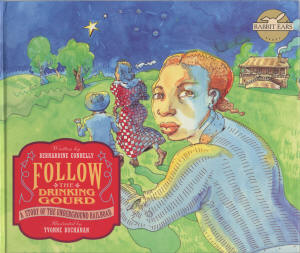
Originally released on VHS. Rabbit Ears Productions: Rowayton, CT,
1992
Author: Bernardine Connelly, Illustrator: Yvonne Buchanan. Narrator:
Morgan Freeman, Music: Taj Mahal)
Cassette and CD versions first published in 1993.
Book: Simon & Schuster, New York, 1997.
Other versions: book/CD combination. Another edition of the book was
published by Abdo in 2004. A version may be forthcoming from Simon &
Schuster.
Synopsis
Introduction: A quail calls in the night, bringing to mind Follow
the Drinking Gourd. (Caveat: bobwhite quail do not call at night.
See
[2])
Story: 11-year old Mary Prentice, her mother and brother Samuel are
enslaved on a cotton plantation outside Mobile, Alabama. Mary's father
had been sold away five years earlier. Mary overhears other slaves on
the plantation relate that her brother Samuel is soon to be sold. She
sees a journeyman carpenter working away, and hears him sing a strange
song, which turns out to be Follow the Drinking Gourd. Returning
to her quarters, Mary repeats the song. Her mother silences her. She
explains that the carpenter is Peg Leg Joe, an Underground Railroad
agent, and that he had known her father. She shows Mary the "drinking
gourd" star formation in the sky and explains the song.
The next day, her mother hands Mary a small whittled gourd to give
Joe – a sign that the family is ready to flee. That night, the family
runs away, making for the Tombigbee river. They find Peg Leg Joe's marks
on the ground. After the marks run out, they travel on for days.
Famished, they stop at a farm to ask for help from the slave quarters.
An old man assists them, giving them a sack with food and pepper.
He tells them the countryside has been alarmed and that they are being
followed. A few days later, the escapees shake off the dogs using the
pepper.
(6)
They continue on until they come to a riverfront town on the Tennessee.
A Quaker man assists them, taking them upriver hidden in a boat with
a false bottom. (The book gets the song's geography wrong here, see the
details below.) They once again find Peg Leg Joe's prints, and then
Mary's Papa emerges from the trees. Papa leads the family to the cove
where Peg Leg Joe and his boat await them. Joe rows them across the
Ohio, to the next stage of their flight to freedom.
Comments
The author wrote, "The sources I drew from were those generally
available to the public, primarily general interest books on the
Underground Railroad...I was especially moved by the photos of Harriet
Tubman."
There is no connection between this version and the other children's
books. "I am an admirer of the Jeannette Winter book, but...had not seen
(it) until after the R(abbit) E(ars) video was released."
The program aired several times on the Showtime cable network in
1993, and won a network award.
Notes for Parents and Teachers
Suitable for Grades 2 through 4. If this book is used to
introduce children to the Underground Railroad, parents and teachers may
want to explain that this is fiction, just one escape account out of
many thousands, and depicts a series of unusual circumstances. Most
slaves escaping from the Deep South
did not head north.
Most escaped alone; family groups were relatively unusual.
(1) Contact with Underground Railroad conductors
in slave territory, especially in the Deep South, was extremely rare.
Parents should know that the lyrics of the song as presented were
published by Lee Hays in 1947 and so could not have been sung by escaping
slaves. The Hays version, particularly the line, "The old man is
awaitin' for to carry you to freedom" conformed to the Underground
Railroad mythology of the mid-20th century, where whites played a
pre-eminent role and slave initiative counted for a distant second.
Today one could argue that slaves who made it to and past the Ohio had
already carried themselves to freedom and didn't need an old man
to do it for them.
The book gets the river systems' geography wrong, "As the song said,
the river – the Tennessee – ends between two hills and there's another
river on the other side." In fact, the river that ends between two hills
is the Tombigbee. The book incorrectly inserts an overland section
between the end of the Tennessee River journey and the runaways' arrival
at the Ohio.
Reviews
AudioFile (review of the audio version)
"Morgan Freeman dramatically reads the story of a slave family's
escape to freedom by way of the Underground Railroad. With just the
right amount of change in vocal pitch and pacing, he effectively
transports listeners as the family travels northward and makes them
feel the dangers of the journey. Taj Mahal provides vocal and
instrumental accompaniment using guitar, harmonica, banjo and
mandolin which add authenticity. The bluesy tunes will echo in
listeners' memories and are repeated without narration on the second
side. The telling of classic family stories in audio format just
doesn't get any better than this."
Awards
Worldfest Houston Gold Award, 1993
Chicago International Children's Film Festival Special Animation, Jury
Award, 1993
New York Festivals Gold Medal, 1993
Parents' Choice Silver Honors (video), 1993
National Educational Film & Video Festival – Gold Apple, 1994
Parents' Choice Gold Award (audio), 1994
Best Spoken Word Album for Children, Grammy Award nomination, 1995
AUDIOFILE Earphones Award
Pamela Dell, Aquila's Drinking Gourd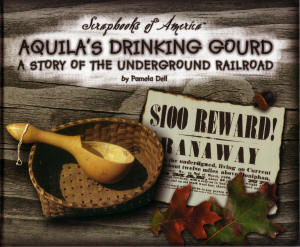
Aquila's Drinking Gourd, Pamela Dell, Tradition Books, 2003,
Excelsior, MN
Synopsis
The book is set in western Virginia, in 1859. The protagonist, Aquila,
is an 11-year-old slave. Aquila is auctioned and separated from her
mother; her father had previously been sold South. Earlier he had
explained how to navigate using the sun by day, and by the North Star by
night. He taught her the Drinking Gourd song and gave her her own
drinking gourd.
Aquila's new "owners" are the Brockett family. Upon arrival at the
farm, she is held in a tiny cellar room under the house, where she
remembers the song. Moss, a slave boy on the farm one or two years older
than Aquila, rescues her and tells her an Underground Railroad conductor
is coming that night to escort him to safety. The conductor, a huge
white man nicknamed "Tiny", escorts them north of Charleston and on to
the Ohio River, opposite Gallipolis, Ohio. There they are rowed across to
freedom.
Comments
The book is handsomely done and takes the interesting approach of
twinning a fictional narrative (by Ms. Dell) with historical content
prepared by others. Unfortunately, the book is replete with errors,
principally in the historical content. I highly discourage its use in
schools or at home. My notes are below.
Notes for Parents and Teachers
"Slaves in the ante-bellum south sang this version of 'Follow
the Drinking Gourd':
When the sun comes back and the first quail calls,
Follow the drinking gourd.
For the old man is awaiting for to carry you to freedom,
If you follow the drinking gourd." p. 22.
This version of the song lyrics was first published in 1947 and could
not have been sung by slaves. In fairness, many other references make the same mistake.
"Some masters offered as much as $40,000 for slaves to be
returned to them!" p. 25.
This $40,000 figure is more than the real estate value of most
plantations of the time! It has been soundly debunked. According to this
inflation calculator
$40,000 in 1860 would be worth $821,706 in 2005 money.
p. 28. "Harriet Tubman was a famous abolitionist who used to
be a slave herself. In this picture, she is on the far left,
standing with some slaves she helped escape."
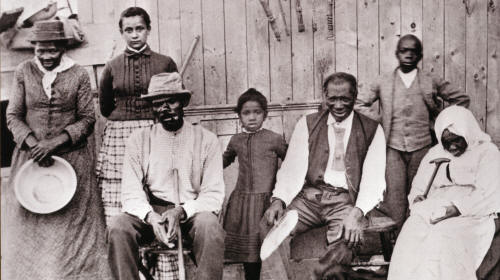
Actually, she is posed with family and friends; she is not known to
have helped any of them escape. (Source: Historian Kate Clifford Larson,
Ph.D., author of Bound For The Promised Land: Harriet Tubman,
Portrait of an American Hero, personal communication.)
"Benjamin Franklin and George Washington didn't believe in
slavery. They were members of the Pennsylvania Abolition Society,
which started in 1787." p. 30.
This is the wrong founding date for the PAS, which began in 1775
(Source.)
I know of no evidence that Washington was a member – he actually wrote a
letter castigating them in 1786
(Source.) Last,
saying Washington didn't believe in slavery is quite a simplification of
a very nuanced position: there were 316 slaves on his plantation at the
time of his death (Source.)
"Tiny took a candle from his coat and lit it up. Then he drew
us a map in the dirt. Showed us that we were a ways north of
Charleston, near where Widow Brockett had her farm." (p. 32.)
The Drinking Gourd song outlines a route from Mobile, Alabama up
the Tombigbee River to northeast Mississippi, over the divide to the
Tennessee River and Tennessee, and then ending at the confluence of the
Tennessee and Ohio Rivers at Paducah, Kentucky. Since the route's end
point is nearly 400 miles from Charleston (mostly due west) it would
have been no use navigationally for a slave in western Virginia. The
book does acknowledge that the song had
"instructions for slaves deeper south to get free but clues
for us, too." (page 22)
Clues in the surviving verses that are not route-specific are limited
to a suggestion to leave in the spring, and an exhortation to keep
traveling north.
"Birds come back after winter." (pp. 22 & 23)
Of course, some birds do migrate, but not the bobwhite quail referred
to in the Drinking Gourd song and pictured in the book. These quail are not migratory. In
fairness, many other references make the same mistake.
"More than 700,000 slaves lived in the South in the
mid-1800s." (p. 40.)
This figure is wildly incorrect. The total was closer to 4 million in
1860
(Source) (James M. McPherson, The Negro's Civil War, New York:
Pantheon Books, 1965, Appendix A.)
"Slaves were brought to the American colonies as early as
1619…" p. 40.
The first blacks to arrive in the colonies, at Jamestown, were
indentured servants.
(Source)
"They (the Underground Railroad) helped between 50,000 and
100,000 runaway slaves travel the Underground Railroad…Slaves made
the dangerous journey north into Pennsylvania, Ohio and Canada." p.
41.
What about other border states, such as Iowa,
Indiana, Illinois? And the states north of them?
"Slave traders continued to bring slaves to the United
States…into the early 1800s." p. 40.
Seemingly contradicted by the text three pages later:
1859: "The Clothilde, the last slave ship to bring slaves to
the United States, lands in Mobile Bay, Alabama." p. 43
In any event, the correct date is July, 1860 and the correct spelling
is the "Clotilda". (Source: Michael Thomason, "From the Archives:
Researching a Legend", Gulf South Historical Review 15 [Fall 1999], pp.
102-106.)
"Harriet Tubman escapes slavery and later returns south at
least fifteen times to help rescue several hundred others." p. 43.
The several hundred figure is inaccurate; the true figure is closer
to 70.
In fairness, many other references make the same mistake.
(Source)
The caption under the poster on page 7 is intended for the poster on
page 35, and vice versa.
|